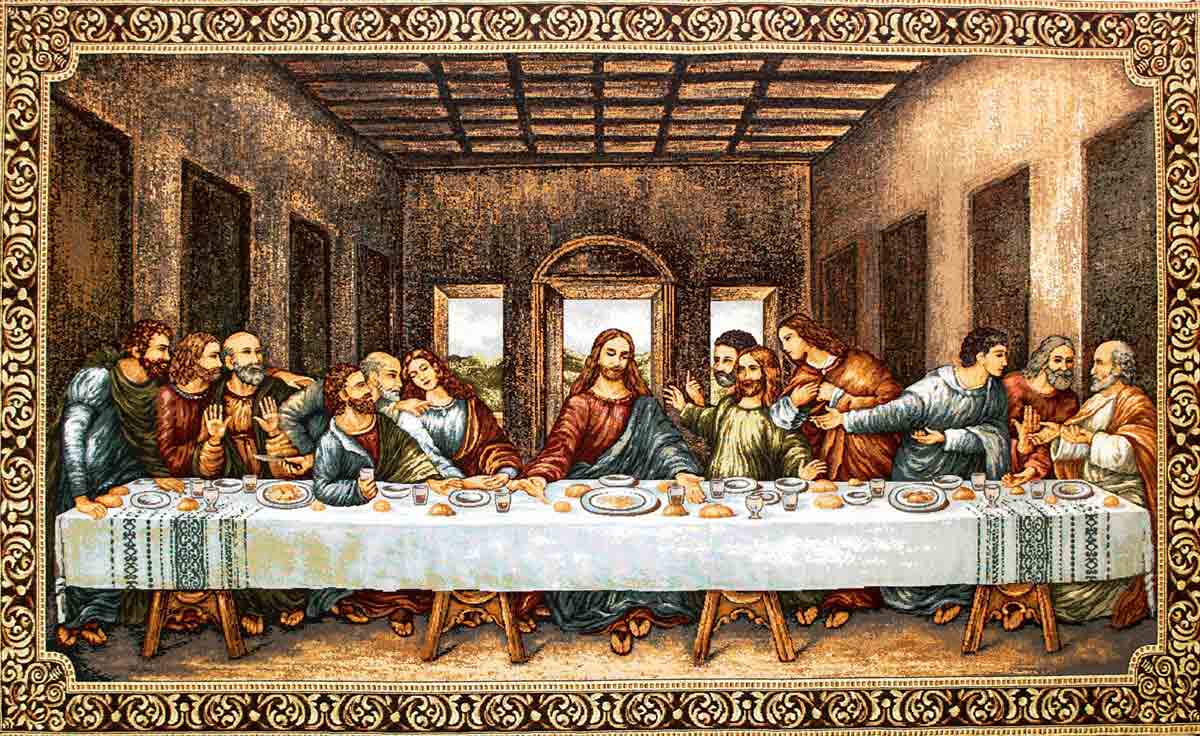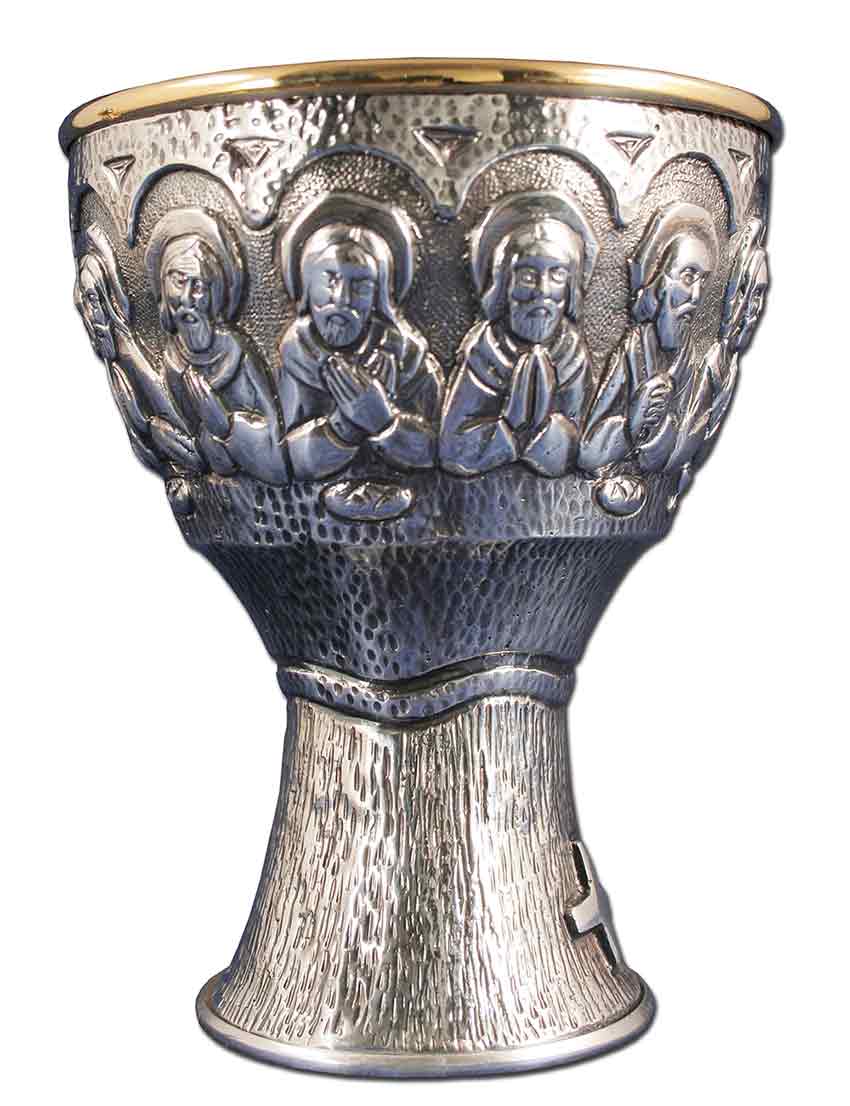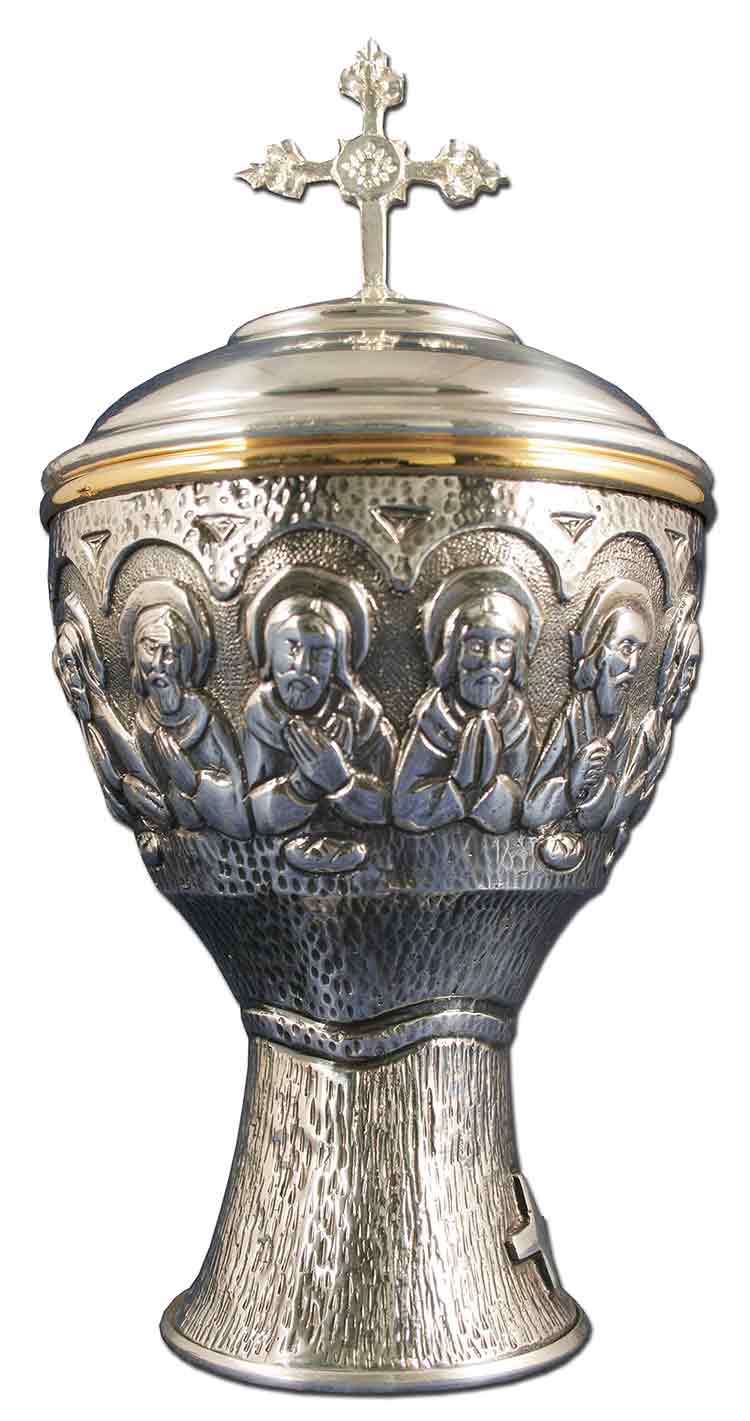
Tapestry of the Last Supper by Leonardo Da Vinci
Tapestry of the Last Supper by Leonardo Da Vinci
The Last Supper of Jesus with the Apostles is one of the most important moments in the last days of Christ's life. Many of the religious items in our catalog recreate this event: chalices, tapestries,... and, of course, the Holy Week Passage of the Last Supper , one of the most important pieces of religious imagery in our online store.
To present our new tapestry of the Last Supper inspired by Leonardo Da Vinci 's mural, we thought it appropriate to know a little more about one of the most important works of this universal genius of the Italian Renaissance.
Tapestry of the Last Supper
The Last Supper by Leonardo Da Vinci is a religious work known throughout the world. It is considered one of the most important paintings of universal religious art. To pay homage to Leonardo Da Vinci and his immortal work, we have created a tapestry that reproduces the mural of the Last Supper.
The tapestry is a hanging piece. Many of our clients have also taken advantage of the texture and shape of the tapestry to frame it and create a painting. The tapestry is 42 cm. high and 70 cm. wide which gives it a considerable size.
It is made with viscose and cotton which guarantees long-lasting colors.
The Last Supper by Leonardo Da Vinci, culminating work of religious art
The mural of the Last Supper (also known in Italian: Il cenacolo or L'ultima cena) is considered by many critics to be the most important work of the Renaissance and even of the history of universal art. The Last Supper was painted by the great Italian artist Leonaro Da Vinci. It is known that it began in the year 1495. But it is not known for sure if it ended in the year 1497 or in the year 1498.
The Last Supper was commissioned by Ludovico Sforza, known as El Moro, Duke of Milan. The Last Supper was painted by Leonardo Da Vinci in the refectory, dining room, of the Dominican convent of Santa Maria delle Grazie in Milan (Italy). The Last Supper is a mural with 4.60 m. high by 8.80 m. Wide.
The reasons why Leonardo Da Vinci's Last Supper is considered one of the most important works of universal religious art are many.
Leonardo Da Vinci, innovative Renaissance genius
Leonardo Da Vinci is remembered as one of the most versatile people in history. He was a painter, artist, philosopher, inventor, and a long etcetera. In the field of painting, he developed new methods never used before.
At the Last Supper, Leonardo Da Vinci tries out a new technique for mural painting. He uses tempera and oil on layers of plaster spread over the wall. The reason why he uses this new technique is the limitations posed by the fresco painting used in previous religious works of art. Fresco is a technique that guarantees good results if done quickly, without waiting for the paint to dry. Leonardo Da Vinci's work methodology requires a slower process, thought out each one of the brushstrokes. His experimental technique allows him to assess each advance that occurs at the Last Supper until he reaches the degree of perfection he desires.
The problem with the new technique used by Leonardo Da Vinci in the Last Supper is its preservation . Over the years, the Last Supper has undergone numerous restoration processes. The last of them spanned the last quarter of the 20th century.
The Last Supper by Leonardo Da Vinci, the dramatic moment
Another of the elements considered innovative in Leonardo da Vinci's Last Supper is the moment he selects to place the painting: Jesus announces to his Apostles that one of them will betray him . According to John 13:21 “When the time came, Jesus sat down at table with the apostles and said to them, 'I longed to eat this Passover with you before suffering. Because I tell you that I will not eat it again until it is the new and perfect Passover in the Kingdom of God, because one of you will betray me'"
In the previous representations of the Last Supper scene (tapestries, paintings, sculptures, etc…) Jesus and his Apostles are represented in much less dramatic moments than the announcement of the betrayal.
Placing his Last Supper in this important moment, Leonardo Da Vinci uses all his knowledge to express what he calls "the movements of the Soul" . That is, the reactions of each of the Apostles to the announcement that Jesus has just made to them. Jesus is in a calm, leisurely position. Making a gesture that many authors associate with the Eucharist. The Apostles each react in a different way, but it can be affirmed without fear of being wrong, that all of them are agitated, the affirmation has caught them off guard. They talk to each other uneasily, not knowing what to say or think. Someone raises his hands as a sign of innocence, another points to himself asking Jesus, etc… Breaking the line of the other Apostles, Judas appears , the fourth from the left if we take into account the heads. He is sitting, leaning back. He does not seem calm, but his gesture does not show the agitation of the other Apostles.
The Last Supper by Leonardo Da Vinci, perspective and balance
The spread of Renaissance principles throughout Europe brought with it new challenges for the religious artists of the time. The use of mathematical perspective as the main way of distributing the figures in tapestries, canvases, murals, paintings, etc... led the authors to face a new challenge, the restoration of the classical balance.
The works under the new mathematical perspective seem rigid, without the natural grace that the works of the great classical artists gave off. Leonardo Da Vinci was one of the first artists to manage to combine both aspects with amazing results. The Last Supper is one of the best examples of this important milestone.
In the Last Supper the head of Jesus is the starting point of the entire composition. From that point the lines that will serve as axes to give perspective to the entire painting begin. The technique used by Leonardo Da Vinci on the side walls and the ceiling of the room deepen the sensation of depth, making it look like an extension of the dining room of the Dominican convent.
Leonardo Da Vinci achieves balance at the Last Supper by utilizing various methods. The first of them is the symmetry that the painting gives off . Taking Jesus as the central point, if a vertical line were drawn over his figure, the mural could be divided into two almost completely symmetrical parts.
The distribution of all the figures in the religious work is also very important. Jesús is in the central area located in a somewhat isolated way. The twelve Apostles are placed in four groups of three figures . Considering the heads, from left to right: Bartolomé, Santiago el Menor and Andrés in the first group; in the second group it is formed by Judas Iscariot, Simón Pedro and Juan; Tomás, Santiago el Mayor and Felipe in the third group; Mateo, Judas Tadeo and Simón el Zelote in the last group. With this distribution, Leonardo Da Vinci manages to give the Last Supper a compact, almost geometric composition, different from the representations that had been made up to that time.
Passage of Holy Week of the Last Supper
As mentioned before, in our online catalog we have a wide variety of religious articles of the Last Supper . This moment of the last days of the life of Christ is very important in any Holy Week . At the Last Supper, a series of events take place that define Christian celebrations: the establishment of the Sacrament of the Eucharist , Jesus offers us his body and blood for the forgiveness of sins; Christ washed the feet of the Apostles ; and there is the announcement of two events that will mark the Death and Resurrection of Jesus, the announcement of the betrayal of Judas and the triple denial of Peter ; Jesus gives us a new commandment, a commandment of love " That you love one another; as I have loved you ", etc... It is a theme widely used for the decoration of chalices, tabernacles, per diem holders, ciboria, etc. In short, objects related to the Eucharist.
Without a doubt, the most popular religious article of this theme that we have for sale in our religious articles store is the Holy Week Passage of the Last Supper . The reasons for its notoriety are varied. It is a work of imagery made of pulp wood, a material specially designed for the procession of El Paso. The thirteen figures are made with glass eyes, which gives them extraordinary expressiveness. The Passage of Holy Week of the Last Supper follows the tradition of Leonardo Da Vinci and, chronologically, is located at the moment in which Jesus announces that he will be betrayed. The reactions of the Apostles show the drama of the situation. The faces of the images transport us to that room, where the Master is shown with serene calm involved in the restlessness of his disciples. The sculptural group has an average height of 160 cm. They are almost life-size figures . The sale price of the Holy Week Passage of the Holy Supper includes the figure of Jesus Christ, the twelve Apostles, the table of the Last Supper and a base to place all the images.
In addition to this magnificent Passage of Holy Week of the Last Supper , in our online store of religious imagery we have for sale images of the Virgin of Guadalupe , figures of Saints , images of Saints , etc...



